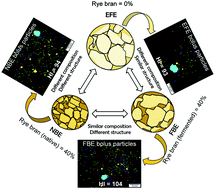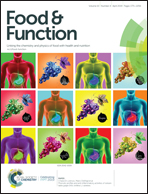The effect of structure and texture on the breakdown pattern during mastication and impacts on in vitro starch digestibility of high fibre rye extrudates
Abstract
The snack product category is lacking palatable, high dietary fiber containing products. This study explored how the addition of native or fermented rye bran influences the texture and sensory properties of endosperm rye flour based extrudates. In addition, mastication and bolus properties (n = 26), and in vitro starch digestibility were assessed. Three high fiber extrudates based on endosperm rye flour (EF) were produced with addition of either 40% native rye bran (NBE) or 40% fermented rye bran (FBE), and with no added bran (EFE) to achieve two pairs of extrudates to compare. EFE and FBE had different composition but resembled each other regarding macrostructure and the second pair (NBE vs. FBE) had similar core composition but different structure due to bran fermentation. The fermentation of bran was performed using exopolysaccharide (EPS)-producing strain Weissella confusa, which led to 3% (3 g per 100 g bran; dry weight) in situ dextran production. The compositionally similar extrudates (NBE vs. FBE) varied in both structure and instrumental texture: FBE were less dense, less hard and crispier than NBE. The extrudates with different composition (EFE vs. FBE) varied regarding instrumental texture: FBE were less hard and crispier than EFE. There were also subtle structural differences FBE being somewhat denser than EFE. NBE and FBE differed regarding sensory texture while textures of EFE and FBE were perceived similar. Mastication properties of the different products did not exhibit remarkable differences. There was a large number of smaller particles in both NBE and FBE bolus samples. The fragile structure of FBE, and its lower bolus viscosity, led to high in vitro starch digestibility. The results demonstrate that the structural attributes of the extrudates, rather than the core composition, dictate the breakdown pattern during mastication and in vitro starch digestibility. The extrudates with similar composition may be digested at different rates depending on their structural attributes. Although FBE had higher in vitro starch digestibility, its high DF content, palatable texture and improved sensory properties were important determinants underlying eating quality and therefore it could be a promising product to snack food category.



 Please wait while we load your content...
Please wait while we load your content...